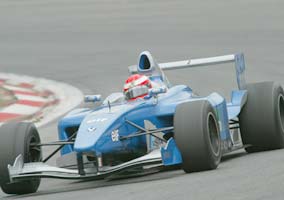>> Formula V6 2004 >>
MONDINI UND PROETTO IN DER EUROCUP FRV6 MEISTERSCHAFT
ZWEI WEITERE FRV6 IM EUROCUP UND NORDAMERIKA 2004-2005

New for the 2003 season, the Formula Renault Eurocup features the Formula
Renault V6 single-seater, the latest word in cutting-edge racing cars
from Renault Sport Technologies.
It took part in its first official shakedown session earlier this year,
on April 5/6 in Barcelona, and tops a four-strong range of Renault single-seaters
that already includes FR Campus, FR 1600 and FR 2000. Renault regards
its V6-powered racer as a suitable final stepping stone for drivers chasing
a future in F1 – and that’s the philosophy that helped shape this new
category, both in terms of the cars’ technical specification and the sporting
regulations. The purpose of Formula Renault V6 is to help train drivers,
engineers, mechanics and team managers for a future in Grand Prix racing.
The chassis was built to very strict guidelines and the monocoque conforms
to the same stringent standards laid down for the FIA F3000 series. The
3.5-litre V6 has already been seen in production cars such as the Vel
Satis and Espace IV. It develops 370 bhp and is tuned for reliability
– it will run for two seasons between rebuilds. Magneti Marelli developed
the engine’s electronic management system and Michelin made the tyres
especially for this formula. As in F1, drivers have steering wheel-mounted
paddles to operate a sequential gearshift and they brake with their left
feet. Elsewhere, the suspension features torsion bars and adjustable dampers.
In the right circumstances, cars will reach a top speed of 275 km/h (170
mph). To supplement their education, drivers have the chance to acclimatise
to car-to-pit radios, telemetry read-outs, mid-race tyre stops and steering
wheels with electronic data screens. They also practise traditional, European-style
standing starts as well as the rolling starts that are a feature of premier
American series such as IndyCar or Champ Car.
Renault insisted on working with partners it could trust – and that’s
another of the category’s strong points. Italian company Tatuus, a long-standing
Renault Sport partner, was commissioned to build the chassis while other
loyal collaborators such as Michelin (tyres), Elf (fuels and oils) and
Magneti Marelli (electronics) are also closely involved.
Last but not least, the new series has earned a place as part of the LG
Super Racing Weekend package, which guarantees strong media exposure in
Europe. The championship takes place on 10 tracks throughout the continent
and TV company Eurosport (which broadcasts in 54 countries and 18 languages)
is a powerful promotional ally. Eurosport televises Saturday races live
and shows Sunday’s event as part of its LG SRW wrap-up, which is shown
at peak time on the Friday following each meeting.
Races
The 2003 Eurocup features 10 events, each of which comprises two races.
Every weekend, there are three hours of free practice before Friday’s
two 30-minute qualifying sessions. The first of these settles the grid
for the opening race and the other one determines the line-up for the
second.
Feature Event – Race 1 (Saturday): This lasts for 50 minutes, at most,
and involves a mandatory pit stop to change rear tyres. When cars come
into the pits, teams are limited to a maximum of three personnel per driver.
The crew will be wearing fire-resistant helmets, overalls, gloves and
boots in team colours. The tyre change takes place in an area of the pits
that is allocated to each team on a permanent basis at the start of the
season.
Super Sprint – Race 2 (Sunday): This time competitors make a US-style
rolling start and the race lasts for a maximum of 40 minutes. After each
event, the first three finishers are required to attend the podium ceremony
before going into the official press conference.
Budget When Renault came up with this idea it was determined to cut budgets
and make the series more cost-effective than rivals such as F3000 or the
Nissan World Series. Each car costs €130 000 and a seasonal budget is
about €500 000. To help combat that, Renault and its partners are making
€600,000 available in prize money.
10 Circuits & 19 races
52 hours of driving (testing not included)
Entry to the Championship : 15.000 €
Prize of a ready-to-run FRV6 : 130.000 €
Prize money : 47.500 € par course / 125.000 € en fin de saison
13 hours 30 minutes of Eurosport coverage
5 hours of coverage on the Eurosport network
18 languages – 54 countries
95 million homes
226 million viewers
2.5 million visitors to the internet sites
350 000 spectators at the circuits